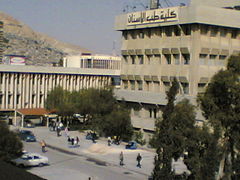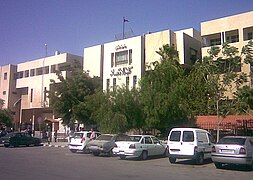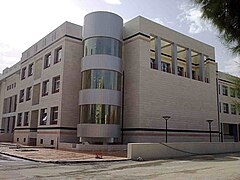Damascus University
جامعة دمشق | |
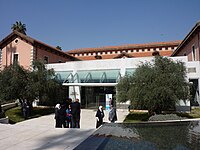 Damascus University | |
Former names | Syrian University (1923-1958) |
|---|---|
| Motto | "وَقُل رَّبِّ زِدْنِي عِلْمًا" |
Motto in English | And say: My Lord, increase me in knowledge (Quran, 20:114). |
| Type | Public |
| Established | 1923 (Medical School in 1903) |
| President | Mohammad Hassan Al Kurdi [1] |
| Students | 210,929 [2] |
| Undergraduates | 197,493 |
| Postgraduates | 13,436 |
| 1,211 | |
| Location | , |
| Campus | Urban |
| Colours | Raspberry [3] |
| Website | damascusuniversity.edu.sy |
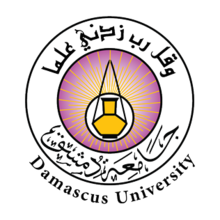 | |
The University of Damascus (Template:Lang-ar, Jāmi‘atu Dimashq) is the largest and oldest university in Syria, located in the capital Damascus and has campuses in other Syrian cities. It was founded in 1923 through the merger of the School of Medicine (established 1903) and the Institute of Law (established 1913). Until 1958 it was named the Syrian University, but the name changed after the founding of the University of Aleppo. There are nine public universities and more than ten private ones in Syria. Damascus university was one of the most reputable universities in the Middle East before the war in Syria started in 2011.
The University of Damascus consists of several faculties, higher Institutes, intermediate institutes and a school of nursing. One of the institutions specializes in teaching the Arabic language to foreigners, which is the largest institution of its kind in the Arab world.[5]
History

The history of any university is inseparable from the history of its country, for the events and chronicles of the latter play a large role in the history of the former. Thus Syrian’s modern history left its mark on the journey of Damascus University.
In 1901, the establishment of the Office of the School of Medicine in Damascus was approved and in 1903 this school, which is the nucleus of the University, opened. The school included branches in medicine and pharmacy, and the language of instruction was Turkish.
In 1913, a Law School opened in Beirut, in which most of the teachers were Arabs and the language of instruction was Arabic. Then this school was transferred to Damascus in 1914 just as the School of Medicine moved to Beirut. Then in the last years of the First World War the Law School returned to Beirut.
Following that the Institute of Medicine and the School of Law opened in Damascus, the former at the beginning of January in 1919 and the latter in September of the same year.
In 1923, the School of Law was named the Institute of Law and this institute was linked together with the Institute of Medicine, the Arab Society, and the Center of Arabic Heritage in organization under the name of the Syrian University. Then the Arab Society and the Center of Arabic Heritage separated from the organization in 1926.
In 1928, the School of Higher Literary Studies was established and it immediately connected its administration with the University. In 1929 it became the School of Letters, which closed in 1935/1936.
Then starting in 1946, the University was no longer limited to the Institutes of Medicine and Law, but rather faculties and higher institutions were created in other subjects.
In 1958, a new law was created to regulate the universities in the northern and southern regions of the United Arab Republic. This led to changing the name of “the Syrian University” to “Damascus University” and to the creation of a second northern university called “the University of Aleppo.” [6]
In 1959, The College of Fine Arts was established in Damascus and became part of Damascus University in 1972.[7] [8]
Structure
Degrees Offered
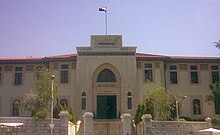
Damascus University awards graduate (Master, Ph.D. Professional Training and Qualification) and undergraduate (Bachelor) degree programs. The period of study for the bachelor's degree ranges from 4 to 6 years, based on the need for each discipline of study. The Master programs combine course work and research, and require a minimum of two years and a maximum of a three. Under certain circumstances, an additional fourth year may be approved by a decision of the university council based on the recommendation of the faculty council. The Ph.D degree is a fully research program. The period of research is not less than two years and not more than five years by the decision of the university council based on the recommendation of the faculty council.[9] although some faculties -Like Faculty of Arts, English Literature Department- does not award Ph.D. degree.
Faculties

- Medicine: Founded in 1903.
- Pharmacy: Founded in 1903.
- Dentistry: Founded in 1921.
- Information Technology: Founded in 1994.
- Civil Engineering: Founded in 1961.
- Mechanical Engineering & Electrical Engineering: Founded in 1963.
- Economics: Founded in 1956.
- Arts and Humanities: Founded in 1928.
- Education: Founded in 1946.
- Agriculture: Founded in 1963.
- Islamic Jurisprudence: Founded in 1954.
- Architecture: Founded in 1960.
- Sciences
- Fine Arts: Founded in 1960.
- Political Science: Founded in 1979.
- Law: Founded in 1913.
- Tourism
Higher institutes
- Higher Institute of Laser Research and Applications
- Higher Institute of Administrative Development
- Higher Institute of Seismologic Studies and Research
- Higher Institute of Languages
- Higher Institute of Translation and Interpretation
The Arabic Language Institute at the University of Damascus is recognized as the best center to study Arabic for non-native speakers in the world. The Center for Arabic Study abroad, the premier U.S. organization for Arabic study, is now opening a second branch at the University. The Arabic Language Institute at the University of Damascus is known for immersion instruction in Arabic, allowing more rapid, natural and comprehensive language acquisition. The Arabic Language Institute’s faculty is committed to classical Arabic instruction, offering an advantage to either Egypt or Jordan where much instruction is conducted in the local dialect.
Technical institutes
The duration of the study is two years, when the graduate students receive a diploma from the institute itself according to the jurisdiction of their choice.
- Technical Institute of Business Administration and Marketing: with the following disciplines: Business Administration – Marketing – Public Relations.
- Technical Institute of Finance and Banking Sciences: (formerly known as the "Commercial Institute", offers associate degrees in the following disciplines: Accounting – financial markets – banking studies. The best students are offered the opportunity to continue their education at the Faculty of Economics.)
- Technical Institute of Medicine
- Technical Institute of Dentistry
- Technical Institute of Engineering
- Technical Institute of Mechanical Engineering and electricity
- Technical Institute of Computer Science
- Technical Institute of Agricultural studies
On 13 November 2012, the President Bashar al-Assad issued a decree on establishing a branch for Damascus University in Quneitra, a city in the Syrian Heights.[10]
Open Learning
The Open Learning Center offers degrees in three majors:
- Legal studies
- Computer and informatics
- Minor and intermediate projects
Library
The University of Damascus Library began in 1903 (with the establishment of the Medical Bureau).[11] As of 2011 it contains some 169,000 volumes and 3,830 current periodicals.[12]
University hospitals

The university runs eight hospitals in the city of Damascus:
- Al Assad University Hospital
- Al Mouwasat University Hospital
- Obstetrics & Gynecology University Hospital
- Cardiac Surgery University Hospital
- Dermatology & Venereal Diseases University Hospital
- Children's University Hospital
- Al Bairouni University Hospital
- Oral Maxillofacial Surgery Hospital
Logo
The emblem of Damascus University reflects the importance of science and endless desire of human for knowledge, as well as the privacy of Damascus in development of science and scientists.
The color of raspberry stands for the damascene raspberry which is a fruit found only in Damascus, expressing the uniqueness of the university just like the fruit. The color is adopted for the signature of the president of Damascus University, a property not shared with any president of any university in the world.[citation needed]
The lamp is the symbol of knowledge in different cultures, it radiates the light of knowledge and science, crowned with a verse from the Quran: "say oh my Lord, increase me in knowledge", which is the motto of Damascus University and its non-stop seeking.[13]
Notable alumni
- Rasha Abbas - author and journalist
- Giles Clarke – chairman of the England and Wales Cricket Board[14]
- Colette Khoury – Syrian novelist
- Dina Katabi – Syrian Professor in the Department of Electrical Engineering and Computer Science at MIT and the director of the MIT Wireless Center
- Gyorgy Busztin - Hungarian Ambassador and U.N. Deputy Special Representative
- Sa'id al-Afghani – former student, then professor and dean of the faculty of arts
- Abdelsalam al-Majali – former Prime Minister of Jordan
- Riad Ismat – Syrian diplomat, writer and theatrical director
- George Percy, Earl Percy - British businessman and the heir apparent to the Dukedom of Northumberland.
- Gerhard Schröder – former chancellor of Federal Republic of Germany, Awarded an Honorary Doctorate
- Nizar Qabbani – Syrian poet, author and diplomat, awarded a B.A. in Law
- Abbas al-Noury – Syrian actor, author, Director and TV presenter, awarded a B.A. in History
- Duraid Lahham – Syrian actor, author, Director and TV presenter, awarded a B.Sc. in Chemistry and Physics
- Farouk al-Sharaa – Syrian politician and diplomat, Syrian Vice President, awarded a B.A. in English Literature
- Aref Dalila – Syrian economist and politician, awarded a B.Sc. in Economics
- Ali Farzat – Syrian caricaturist and painter – awarded a B.A. in Fine Arts
- Rachid Ghannouchi - Leader of Tunisia's Nahda Movement, awarded a B.A. in Philosophy in 1968
- Ibrahim Mughrabi - Football striker, studied law before moving to Greece to continue his studies.
- Mahmoud Abbas President of the Palestinian Authority.
- Georges Tarabichi - Prominent Syrian writer.
Gallery
-
Faculty of Medicine
-
Faculty of Dentistry
-
Faculty of Pharmacy
-
Faculty of Architecture
-
Faculty of Economics
-
Faculty of Civil Engineering
-
Faculty of IT Engineering
-
Higher Institute of Languages
References
- ^ "President of Damascus University". Damasuniv.edu.sy. Retrieved 25 August 2015.
- ^ [1] Archived 14 July 2014 at the Wayback Machine
- ^ "Ř´Řšř§Řą اŮ"Řźř§Ů…Řšřš". Damascusuniversity.edu.sy. Retrieved 25 August 2015.
- ^ "جامعة دمشق". Mohe.gov.sy. 2 January 2012. Retrieved 25 August 2015.
- ^ Spender, Tom. "A new 'Mecca of Arabic studies'?". The Christian Science Monitor. Retrieved 31 March 2007.
- ^ "Historical Background". Damasuniv.edu.sy. Retrieved 25 August 2015.
- ^ Lloyd, Fran (1999). Contemporary Arab Women's Art: Dialogues of the Present. London: Women's Art Library. p. 82. ISBN 1 902770 005.
- ^ Bloom, Jonathan; Blair, Sheila, eds. (2009). The Grove Encyclopedia of Islamic Art and Architecture. New York: Oxford University Press. p. 261. ISBN 978-0-19-530991-1.
- ^ "Degrees Structure of Studies". Damasuniv.edu.sy. Retrieved 25 August 2015.
- ^ Nassr, M.; Ghossoun (13 November 2012). "President Bashar al-Assad decrees on establishing branch for Damascus University in Quneitra". Syrian Arab News Agency. Archived from the original on 16 November 2012. Retrieved 13 November 2012.
{{cite news}}: Unknown parameter|deadurl=ignored (|url-status=suggested) (help) - ^ Basima Bezirgan (1994), "Near East since 1920", Encyclopedia of Library History, New York: Garland Pub., ISBN 0824057872, 0824057872
- ^ World Guide to Libraries (25th ed.), De Gruyter Saur, 2011
- ^ "The logo of Damascus University". Damasuniv.edu.sy. Retrieved 25 August 2015.
- ^ [2]


